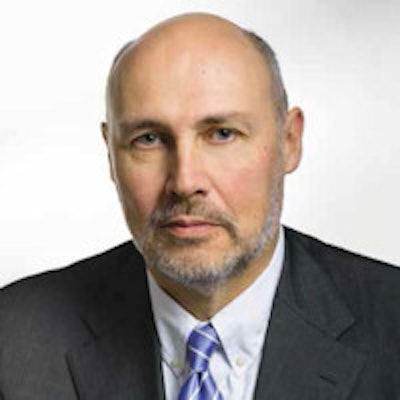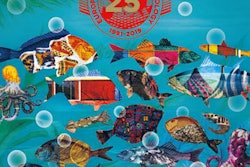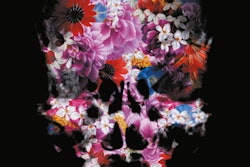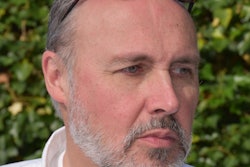
ECR Today spoke with the incoming European Society of Radiology/European Congress of Radiology (ESR/ECR) president, Dr. Paul Parizel, PhD, from Antwerp, Belgium, to learn about this new position, his visions for the society and his ideas for next year's congress.
ECR Today: You are the first officer of the European Society of Radiology to take on the new position of combined ESR/ECR president. Could you please briefly explain to our readers how this change came about and what it means? What are your main tasks and responsibilities in this position?
 Dr. Paul Parizel, PhD, chairman of the Antwerp University Hospital Department of Radiology and full professor of radiology at the University of Antwerp Faculty of Medicine, is the incoming ESR/ECR president.
Dr. Paul Parizel, PhD, chairman of the Antwerp University Hospital Department of Radiology and full professor of radiology at the University of Antwerp Faculty of Medicine, is the incoming ESR/ECR president.Dr. Paul Parizel: It is a great honor, and also a huge responsibility, to assume this new position of combined ESR/ECR president. The ESR is one of the most important and prestigious international scientific societies, with more than 63,000 members throughout the world. The ECR is well-established as the foremost congress in radiology in Europe. Until a few years ago, nominations and elections for the "cursus honorum" of the ECR and ESR were made independently of each other. This implies that we have had brilliant presidents of our society, who never became president of the congress, and vice versa. As both the society and the congress were getting bigger, and more mature, it was decided to re-evaluate and retune the strategic plan and to change the statutes so that appointments were fully integrated, instead of running on parallel tracks, as was previously the case. Bringing the congress and the society under one and the same leadership umbrella is an efficient way to better utilize our resources (human, political, and financial). I am convinced that this will improve communication with our members, enhance our international standing, and facilitate relationships with other societies and with the industry.
This combined ESR/ECR presidency is certainly a daunting task, and I admit that I am a little bit nervous. On the other hand, I can rely on the work of my predecessors and especially on the creative input and unflagging energy of my friends and colleagues of the Board of Directors, the Executive Council, the statutory committees, subcommittees, working groups, and, last but not least, the experience, professionalism and efficiency of the ESR staff. Our society is healthy, both politically and financially, and we are steering a stable and steady course.
One of your tasks is chairing the ECR Program Planning Committee, which means together with your team you are in charge of the scientific program of ECR 2017. How is the Program Planning Committee composed and how often do you meet?
The ECR Program Planning Committee (PPC) consists of six persons: the chairperson of the committee (who will be president at the time of the congress), the deputy chairperson (who will be first vice president), one ordinary member (president of the preceding congress), the executive director of the ESR, the chairperson of the Finance and Internal Affairs Committee, and the chairperson of the Education Committee.
It has three large subdivisions: the Postgraduate Educational Program Subcommittee (chaired by Dr. Hans-Ulrich Kauczor and containing 12 members), the Scientific Papers Subcommittee (chaired by Boris Brkljačić, PhD, and comprising seven members), and the section coordinators (17 members).
Our PPC for ECR 2017 is carefully constituted, with bright and talented individuals of different ages and backgrounds, representing many nationalities and specific areas of expertise and knowledge.
Of all my duties as ESR/ECR president, chairing the PPC is one of the most pleasant tasks. We first met in an inaugural session, in early December 2015. Further dedicated meetings are organized by working groups, based on the different schedule. Our meetings are true brainstorming sessions, and many innovations and new ideas are formed around the table.
I consider it a privilege and an honor to lead this group, and I often feel like the conductor of a symphonic orchestra, working together with all the musicians toward improving and fine-tuning our great symphony, which will be ECR 2017.
What will be some of the scientific highlights of ECR 2017; and what are your own favourites?
The central theme of ECR 2017 is "youth," and this focus on the young(er) age group shall be reflected throughout the program of the entire meeting. The new generation of radiologists demands high-quality education, delivered in an efficient and understandable way ("customer-friendly"). We shall have more and improved interactive sessions, and I want to create a greater role for social media, giving more young people the opportunity to share their knowledge.
What will be the highlights of ECR 2017? It is hard to predict on an individual basis, because the ECR 2017 PPC is committed to bringing something for everyone. The European Excellence in Education (E3) ECR Academies will include sessions on spinal imaging (combined neuroradiological/musculoskeletal approach), abdominal imaging, ultrasound, and, last but not least, Interactive Teaching Sessions. Other E3 highlights include the Beauty of Basic Knowledge and the European Diploma Prep Sessions.
In addition, as president, I hope that ECR 2017 will also be remembered for the grand opening ceremony, the honorary lectures, the social events, and most of all for the spirit of friendship and conviviality. The essence of the ECR is to provide a platform where high-quality scientific and educational content goes hand in hand with professional contacts and networking.
Radiology is currently undergoing a metamorphosis, and a lot of attention has been focused on functional, biological, and genetics-related imaging. However, we should not forget that the mainstay of radiology is still "anatomical imaging" and that one should learn to walk before one can run. This notwithstanding, we must provide information about cutting-edge techniques to our colleagues and help them to understand that they should not be afraid of innovations, but rather find a way to adopt these techniques to explore new diagnostic pathways and improve existing workflows. Radiology is not only about detecting lesions and offering a differential diagnosis, but also about understanding how the human body works, how lesions arise and behave, and how we can monitor and influence disease processes using radiological techniques and image-guided interventions.
Which countries will be invited to participate in the "ESR meets" program? Do you already know anything about their plans for the sessions?
The "ESR meets" sessions aim to provide a special opportunity to the invited country's radiological community to present one main topic, which is of special importance to the respective country and applies also to other attendees, and at the same time to provide a flavor of the invited country through interludes between the lectures. For ECR 2017, we have invited the U.S., Peru, and Belgium as our esteemed guest countries.
I am very excited about the meeting with the U.S. This session is organized in close collaboration with the American College of Radiology (ACR) and the Radiological Society of North America (RSNA). "ESR meets USA" will focus on clinical decision support strategies, the development of quantitative biomarkers, and "Imaging 3.0/Radiology Cares," which is a joint initiative of the ACR and RSNA.
With "ESR meets Peru," I am inviting an important South American country, with a long history and a magnificent pre-Columbian civilization. The session will allow us to become familiar with radiologists in Peru; in addition, our Peruvian colleagues have promised to teach us about the role of x-rays in Peruvian history research.
The session "ESR meets Belgium" will focus on the important role of radiology in acute conditions, and I am confident that the interludes will offer a typically Belgium flavor of history, humor, food, and drink. The development of these sessions is a creative process, and, if you want to be surprised, I warmly recommend that you attend these "ESR meets" sessions, as they always have some surprises in petto.
Collaboration with other specialties and partner disciplines is a major aim for the ESR, as reflected in the growing number of joint sessions at recent ECRs. Which collaborations are planned for ECR 2017?
For ECR 2017 we shall have a joint session with the European Union of Medical Specialists (UEMS). The purpose of this ESR/UEMS joint session is to provide information about topics such as continuing medical education (CME), accreditation, and certification. These are important subjects for young and old, for recently qualified radiologists as well as for established practitioners. Recently, the ESR has established the Accreditation Council in Imaging (ACI), in collaboration with the EACCME/UEMS; this body will be responsible for accrediting radiological events, e-learning, and other relevant sources of CME in Europe.
The ESR has been drawing an increasing number of younger delegates to its annual meeting; about one-quarter of participants at recent ECRs have been students and trainees. How will this be reflected in next year's scientific program?
As you correctly observed, the mean age of ECR participants has been decreasing steadily, and this evolution has been going on for more than 10 years. Therefore, I have made it a central theme of the congress. ECR 2017 will be dedicated to YOUTH, die Jugend, la jeunesse, la giovinezza, la juventud, молодежь. It is my intention to bring this message to young radiologists, throughout Europe and across the world. The scientific program will reflect this focus on a new generation in radiology: There will be more interactive sessions and a more prominent role for social media, and we will have topics that are of interest to young people, because, after all, they are the future of our profession.
For many radiographers throughout Europe, the ECR is the main scientific meeting of the year. What will be the main issues for radiographers at the next ECR?
Much more than other disciplines and specialties in medicine, radiology is teamwork. The team consists of certified radiologists, residents/registrars in training, radiographers, nurses, physicists, technical support staff, managers, etc. The quality of our performance depends on the strength of the entire team. This is why I am so happy that the ECR collaborates closely with radiographers, and the scientific program for 2017 will reflect this growing symbiotic relationship. A big challenge here is to make sure that we reach our target audience, because there are huge differences across Europe in the definition of the profession. There are even huge differences in the name that the practitioners of that profession have: radiographers, technologists, radiology technicians, imagers, etc. But we have developed strong and positive collaborations and you will see a bigger input in the scientific program in ECR 2017,and in coming years.
Since 2011, the European Diploma in Radiology (EDiR) examination has been an important constant at the ECR. Would you care to share your personal opinion about the significance of the EDiR? What are its advantages and why should young radiologists take it?
The European Diploma in Radiology (EDiR) was created to establish a "standard of radiological knowledge" for the independent practice of general radiology. A few years ago, the ESR defined the "body of knowledge," as laid out in the ESR European Training Curriculum for Radiology. If we want our specialty to continue to grow and blossom, such an objective test of knowledge is necessary. In this respect, the EDiR represents a significant step towards transnational harmonization of radiological standards throughout Europe. I would strongly advise radiologists and radiology residents in their fifth year of training, to participate in this examination. Today, and even more so in the future, the EDiR will be an important element for career development and job applications. Moreover, in the context of medical migration, it will be easier for a radiologist who has successfully passed the EDiR, to use this document as proof of training, and thus hopefully facilitate procedures to apply for work in another country. Finally, and this is important, the EDiR does not replace any national board certificate, except in Poland, who have decided to consider the EDiR as equivalent to the Polish Exit Training Examination, and in Turkey where the EDiR is equivalent to the first part of the Turkish Board Examination, but should be seen as an "added value" with an international dimension. It is a giant step forward in the European integration of our profession, and it serves as a "quality check."
You have been actively involved in the creation of the poster for ECR 2017, which features a stylized skull covered in flowers. How did you choose this particular subject and what does it convey to you?
 The Flower Gardens of Radiology is the theme for ECR 2017. Image courtesy of ESR.
The Flower Gardens of Radiology is the theme for ECR 2017. Image courtesy of ESR.The answer to this question is simple and straightforward: The skull contains the brain, and this symbol reflects my interest in neuroradiology; the colorful flowers are a metaphor for youth, spring, a new dawn, and a new generation in radiology. With this eye-catching poster, I want to invite our colleagues to join me in exploring the beautiful and fragrant flower gardens of radiology.
Radiology is an adventure, a voyage of discovery. And radiologists are like gardeners, cultivating and creating beautiful flowers but also pruning the plants when necessary and weeding the flowerbeds. Presented like this, the analogy with diagnostic and interventional radiology should be obvious. And, on a personal note, let me tell you that, ever since I was a child, I have always been interested in graphic design. My grandfather was a very good artist, and he introduced me to techniques such as charcoal and Chinese ink drawing, as well as oil painting. Throughout my life, I have kept this interest, and the creative process of drawing still gives me joy and pleasure.
To finish on a personal note, what made you choose radiology over any other medical specialty? And how would you "sell" radiology to medical students?
As a medical student, I was interested in many things: anatomy, physiology, neuroscience, computers, and, last but not least, the brain. Neuroradiology and radiology lies at the intersection of all these disciplines. It is the crystallization of pure medicine, and if we take a look at how radiology has developed in the past decades, it has become a crossroads, a common meeting ground for almost all fields in medicine. "E pluribus unum" ("Out of many, one") should really be the motto of our profession.
I hope that future generations of medical students and radiology residents will have the same good luck that I had, which is to be mentored by outstanding and inspiring radiologists and neuroradiologists: Dr. Arthur De Schepper at Antwerp University Hospital (he was my mentor in general radiology), Drs. Juan Taveras and Kenneth Davis at Massachusetts General Hospital (they were my mentors in neuroradiology), and Dr. Danielle Balériaux at Hôpital Erasme and Université Libre de Bruxelles (who introduced me to MRI). I admired them and wanted to become like them, and I never regretted my choice.
Originally published in ECR Today on 6 March 2016.
Copyright © 2016 European Society of Radiology



















